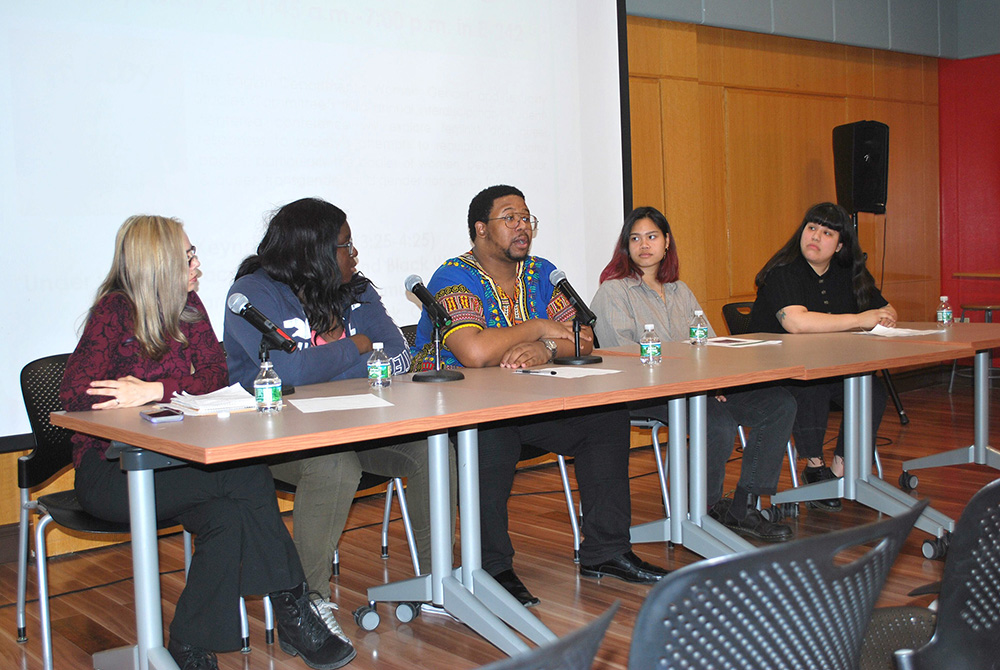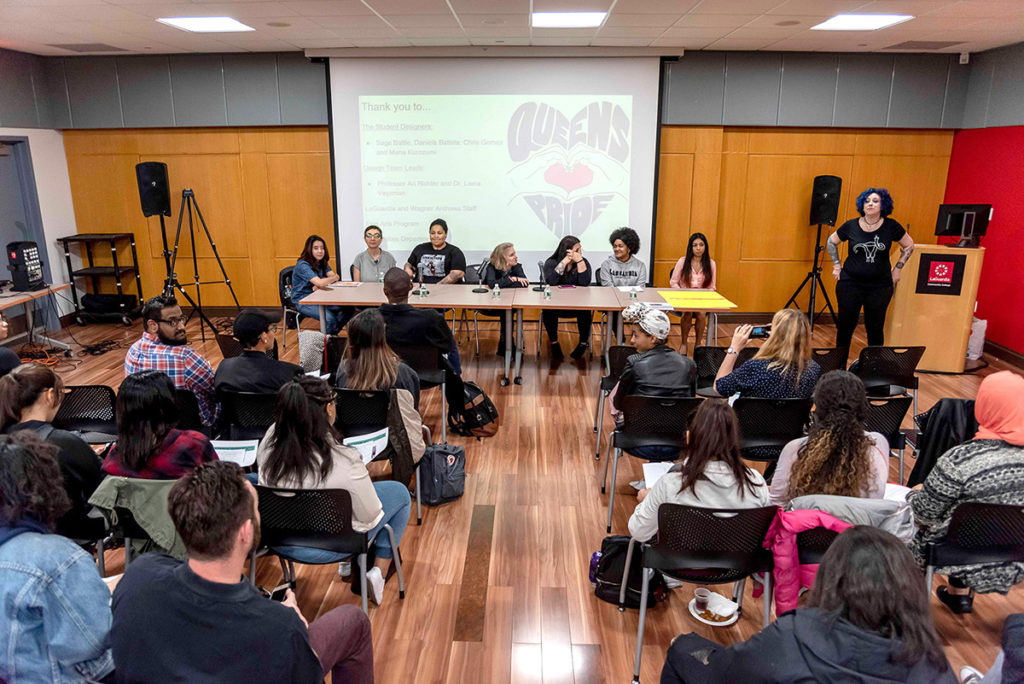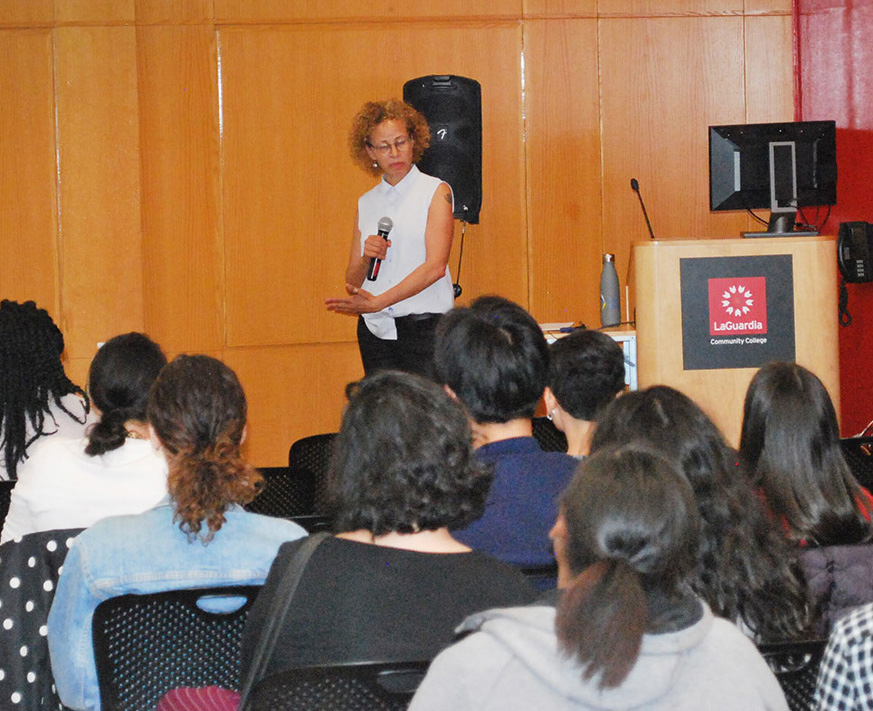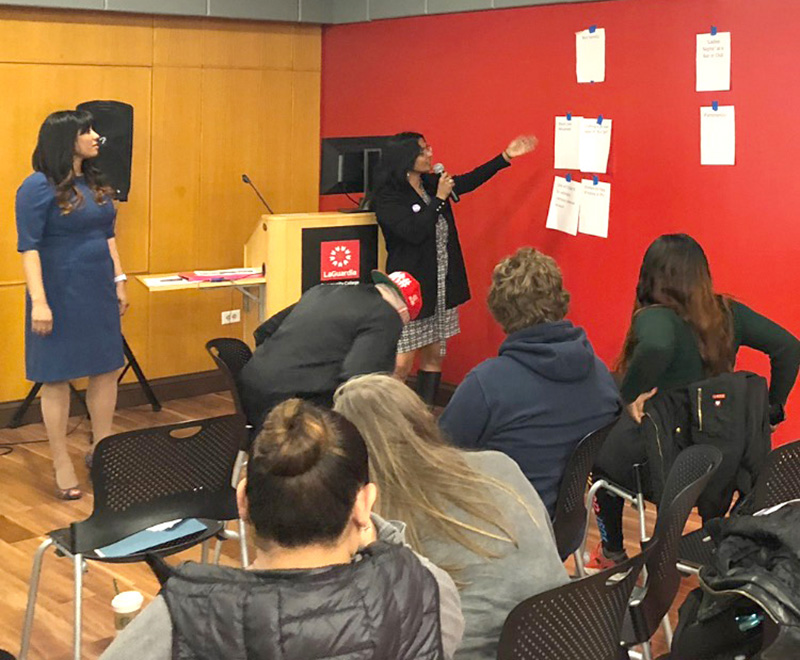The English Department’s Women, Gender and Sexuality Studies Committee hosted its annual interdisciplinary conference on May 2, 2019 at LaGuardia Community College (LaGCC). This year’s theme was “Body Politics.” The main co-organizers of this event, Dr. Meghan Fox and Dr. Anita Baksh, along with many more contributors helped in making this day a success. The conference was held for its third year in a row in hopes of bringing awareness to society’s perceptions and misconceptions on gender and sexuality and its efforts to establish control over people’s bodies. Students learned from the research and experiences of other students, faculty, and staff members. Photography: Luisa Alarcon
Allyship and Visibility
by Kassandra Batres

As students poured into E-242 and found their seats, the panel of speakers prepared for the first topic of discussion, “Allyship and Visibility”.
After introductions, Olive Casareno, the President of the Straight and Gay Alliance (SAGA) organization at LaGCC spoke about the different events that are hosted on campus in hopes of spreading awareness about the LGBTQIA+ community. They spoke about the Red Ball, which is held to bring acknowledgement and understanding of AIDS and highlighted the importance of being well informed. Casareno also spoke about inter-club collaborations to host events like open mic night, which was a collaboration between SAGA and the Lit club. The purpose of the event was to create a safe space for LGBTQIA+.
After Casareno delivered their presentation, Jacqueline Veliz, Program Coordinator for the LGBTQIA+ Safe Zone Hub, discussed the determination many people have on becoming allies without having the proper information needed to fully understand. She explained, “a lot of the work starts with yourself. Educate yourself first. Many people want to be allies to different groups without knowing. Unless you’re a part of that community, you never really have to think about it.”
Veliz provided a blank chart to the audience on the components of sex, gender and sexuality and she filled in each section as she spoke while placing a marker on where exactly she identified herself. The different components were biological sex, gender identity, gender expression, sexual orientation, and sexual behavior. Many people don’t know how to differentiate between them all so she broke each term down and explained how a person can identify as each term and how they differ from one another.
Dr. Lisa Silverman, a professor from the Social Science Department, came up with two of her students, Ama Adjepong and Jabril Gaskin, to discuss their presentation “Dress Codes and the Authentic Self.” They noted that in many schools as well as in the workplace, women are forced to cover up and dress a specific way in order to avert the male gaze and not cause distraction. Through dress codes, women are forced to be responsible for men’s actions and sexual advances.
Media and Art As Activism
by Mariuxi Moran

The “Media and Art as Activism” panel took place from 1 to 2 p.m. It addressed several projects presented by students and faculty members. Dr. Meghan Fox, Co-chair of the English Department’s Women, Gender, and Sexuality Studies Committee, welcomed attendees and introduced Dr. Leah Richards, a committee member and professor in the English Department, as the moderator of this panel.
Autumn Fore, a recent LaGCC graduate of commercial photography, presented her photographic project, “Bi-the way: Drag Queen Culture and Bi-phobia,” focused on her boyfriend’s bisexuality and his performances as a drag queen.
“I don’t really see him like just as his sexual orientation. I saw him as a beautiful person, who was very talented and very caring,” said Fore. She continued, “you don’t see love as gender.”
Fore shared her story and explained that she called her art “Bi- the way” because she is always saying to people, “my boyfriend is a drag queen, by the way. This is my boyfriend.” She added, “I had to always inform people and educate myself.” Fore also explained that she considers drag queen culture as “an appreciation for women,” which is why her photos are used to express feelings and convey a sense of spirituality and femininity.
Next, the project “Women’s Bodies and Forced Sterilization: Responding to the American Eugenics Movements” was framed by Dr. Phyllis van Slyck, a professor from the English Department, with presentations by students in her composition class, Ambar Paulino and Angela Valdez.
Dr. van Slyck provided some background about women’s forced sterilization from the 1930s through the 1970s. “In the early part of the century, 32 states passed legislation allowing for the sterilization of people they considered genetically unfit,” said Dr. van Slyck.
Students in Dr. van Slyck’s class researched the topic and designed creative projects to address the forced sterilization of women of color and disabled women. Paulino read a letter she wrote to a past editor of The Times of Northwest Indiana, protesting the issue.
“Taking away the ability of a woman to have a child is just sick,” said Paulino. “I didn’t know just how bad and how far they were willing to go to eliminate anybody didn’t fit their social standards,” she continued.
Valdez spoke next, displaying an informative pamphlet about forced sterilization that she created with some of her classmates, as a way of warning women. Images including the Red Cross symbol and handcuffs appeared in the pamphlet. Next Mariuxi Moran, a journalism student at LaGCC, presented her article “Edith Evans Asbury: A Legacy in NY Journalism History,” a profile of a former New York Times journalist who covered topics from adoption to Medicaid fraud all throughout the 1960s and ‘70s.
“Known for her journalistic work in The New York Times City Room, Asbury left her hallmark not only in New York journalism history but also within the memory of those who knew her,” read Moran.
She addressed Asbury’s personality, life and successful career through quotes from her friends and colleagues. Moran also shared some interesting anecdotes about the journalist.
In her closing remarks, Moran noted, “Her work as an exceptional journalist, her commitment to the truth, and her courage to challenge an era in which women did not have equal opportunities, live on in spite of her death, keeping Asbury’s presence and memory more alive than ever.”
The last presentation was by Dr. Liena Vazyman from the Humanities Department and one of her students, who together presented the project: “Designing the Queens LGBTQA+ Pride Parade Banner and T-Shirt: Activist Design by LaGuardia Students in the Context of LGBTQ History.”
The project involved a group of Fine Arts students in collaboration with the LaGuardia and Wagner Archives. The goal was to create tshirts for the CUNY Queens Pride Consortium and an exclusively banner to represent LaGuardia Community College during the June 2nd Pride Parade.
“Students started to think about how to incorporate historical photographs with some Queens’s symbols like the Unisphere,” said Dr. Vazyman. “The colors that were chosen are kind of an updated but retro version of the rainbow.” Pictures of the design process were showed with explanation of how every designed symbol represented LGBTQ culture.
“Looking at design is activism for our students. We talked a lot about design, social practice and how this is activism and then, it also was archival-based design. That is an extension of body politics,” said Dr. Vazyman.
Building Bridges: NYC Women’s Organizations
by Kassandra Batres

Dedicated to NYC women’s organizations, the third panel of the Body Politics conference, “Building Bridges” explored the topic of abortion and intergenerational healing between women. Dr. Chelsea Del Rio, a professor in the Social Science Department at LaGCC, delivered the first paper, titled “Clinic Escorting, Clinic Defense, and the Politics of Abortion Activism.” She discussed an issue that is of crucial importance in regard to women’s bodies. Creating controversy around abortion is yet again another tactic used to control women’s bodies and dictate the choices they make towards it.
Dr. Del Rio discussed direct action antiabortion protestors who strive to limit access to abortions and work to create a hostile environment outside the facilities of an abortion provider so as to threaten or dissuade women from entering the building to receive medical care. “It can include anything form praying outside of clinics to lobbying city councils to try and get them to change zoning laws so the clinics can’t open. They try and physically prevent clinic access and then on the most extreme, we see death threats, clinic bombings and there have been abortion staff members who have been murdered,” Dr. Del Rio explained.
She informed the audience of “sidewalk counseling,” a form of anti-abortion activism and interference coming from people who are headstrong in the belief that abortion is a sin and goes against morality. They rally outside of the abortion clinics and aggressively advise women to reconsider their options in an effort to intimidate women to believe that their decision to get an abortion is wrong. They also handout brochures and other pieces of literature that are against abortion.
Dr. Del Rio explained clinic escorting as well. Clinic escorts have the task of accompanying women into the clinic and offer support amidst the chaos of harassment that is sometimes physical, verbal or both. She shared her own experiences as a volunteer, and she reenacted some situations that clinic escorts find themselves in by asking guests in the audience to act the parts of the protestors who badger the women. In today’s political climate, women are not supported enough and the topic of abortion is sensitive to many.
The second speaker and last speaker of this talk, Arita Balaram, a P.h.D student at the CUNY Graduate Center and adjunct professor in the Psychology department at both LaGCC and Hunter College, spoke about her dissertation project on intergenerational healing within Indo-Caribbean women and the importance of oral history. “Healing happens through collective sharing and testimonies,” Balaram explained as she delved into the idea of spaces of healing which consist of listening to the knowledge and opinions of those whom we trust to tell our stories to.
Balaram also mentions the gender roles assigned to women in their families, forcing them to be seen as nothing more than a daughter, sister, mother, grandmother or daughter-in-law. “A project like this is really trying to challenge the idea that women’s stories are only valuable in terms of their roles and that women also have complex roles and lives and wisdom to pass on beyond those roles,” she explained.
Under the Skin: Race, Intequality and Black Womens Bodies
by Rosa Guevara

In her keynote address at the Body Politics Conference, the Program Director of Journalism at the City College of New York, Linda Villarosa, spoke about her New York Times Magazine article, “Why America’s Black Mothers and Babies Are in a Life-or-Death Crisis,” and about the investigating work leading up to it. Her focus was the relationship between racial discrimination and the death rates of black women in childbirth within the American healthcare system.
Throughout Professor Villarosa’s presentation, students were introduced to a range of childbirth statistics, including the fact a black baby born in America is more likely to die as an infant as opposed to a white baby. Her statistics showed that race and racism have influenced the care and treatment given to pregnant women of color.
“We need to realize the health care system does not do as good of a job as we could with mothers and babies of color,” said Professor Villarosa.
Professor Villarosa pointed out that black women are 75 percent more likely to die from pregnancy complications such as brain hemorrhages that take place while mothers are in midst of giving birth.
She uses Serene Williams, an African American professional tennis player who experienced complications while giving birth to her daughter.
“So, Serena Williams had her baby in September. And after the baby was born, she started complaining about having shortness of breath. She had a history of pulmonary embolisms, which is a blood clot in the lungs. So, she was ignored, and her concerns weren’t taken seriously and it led to a crisis. Presumably, this is one of the richest women in the world and one of the most proactive and one of the most powerful,” Professor Villarosa explained.
She also stated, “women have higher reported rates of being discriminated against, whether it was big or small, and had more preterm births.” Her talk was just as in-depth as her article.
Negotiating Queer Identities
by Lineurys Garcia & Tao Zhang

“Negotiating Queer Identities” was the fifthtalk of the day. It began from 4:35 p.m. and ended at 5:35 p.m. This particular talk focused on faculty and staff members form LaGCC who spoke about their areas of research and personal experiences when discovering their own sexuality.
Jacqueline Veliz, an LaGCC alum and the current LGBTQIA Program Coordinator, began her presentation, “Finding a Home in the LGBTQIA+ Community,” by discussing her identity. Having been born in Mexico and raised as a Catholic, it took her nearly 16 years to identify herself as queer. “It took me 16 years to figure out that I was queer and then it took me another two years to accept that queerness,” Veliz explained.
She also spoke about her visit to Mexico, where she spent time interviewing the natives there on how they felt about the term Latinx and how they felt toward gays. To her astonishment, they were welcoming to the idea of a family member being gay. She relayed what her uncle told her on the topic by saying, “once you step out of the room, we can’t protect them and isn’t our goal to protect our family members?”
Her brave soul and her openness about her personal experiences were admired by many students.
Andre Ford, HSE Program Specialist for the CUNY Fatherhood Academy, playwright and adjunct professor at LaGCC, was the second speaker on the panel. His talk was called “Transference and Countertransference: How Members of the Black LGBTQ Community Adopted Hypersexualized Heteronormative Identities as a Framework of Survival and Internalized Oppression.”
Ford interacted with students throughout his presentation by asking questions about their assumptions regarding power in a number of different scenarios, specifically questions based on who might hold the power in a certain scenario. Students were positive and participated by answering his questions followed by laughs on the interesting answers. Students were also treated by two vignettes of Ford’s creation, both of which were spoken from the narrative of a person who were either discreet or closeted in terms of their sexuality.
Dr. Jill Kehoe, a professor in the Social Science Department at LaGuardia, was the final speaker on the panel. Her PowerPoint presentation, “An Analysis of Anti-LGBTQ Hate Crime Offender and Situational Variables” spoke to the theme of the conference by examining the epidemic of hate crimes against the LGBTQIA+ community through the analysis of several years of statistical data.
Dr. Kehoe delved into the topic by explaining her dissertation and how it derived from not seeing any research done on the race and sexual identity of perpetrators who commit hate crimes against the LGBTQIA+ community. “The questions in my head were who are these people that are perpetrating anti-LGBTQ hate violence, hate crimes, hate tacts of any sort and what are the situational dynamic,” she said while goingthrough her presentation.
After years of research, Dr. Kehoe found that most perpetrators were white, male, heterosexual and under the age of 30 – something she knew before she began her research. However, what she found was most of the perpetrators were not under any kind of alcoholic or drug-induced state of mind. “But what I found about situational characteristics were that these did not match what they were saying in the literature. They weren’t a majority of the offenders who were drunk or high. Most of them. according to their victims, were sober,” explained Dr. Kenhoe.
She concluded her talk by leaving the audience with the idea that each hate crime scenario is different and we must acknowledge multiple reasons behind these hate crimes and the circumstances of which they occur for the victim’s sake.
Beyond the Basics: Examining the Continuum of Gender-Based Violence
by Katherine Ramirez

The final panel, “Beyond the Basics: Examining the Continuum of Gender-Based Violence” featured two guest speakers: Dr. Rani Varghese, a social worker and professor at Adelphi University who studied social justice, education, women’s studies multi-level analysis and power, and Dr. Cruz Caridad Bueno, an economist and professor of Black Studies Department at SUNY, New Paltz, whose work focuses on the political economy of race, gender, and class inequality. Dr. Varghese and Dr. Caridad Bueno each shared some of their research before leading students in an interactive discussion regarding the impact of commonplace forms of gender-based violence.
With her intersectional approach , social justice framework and clinical experience, Dr. Varghese has excelled in her field as an advocate for survivors of gender-based violence. She speaks at various colleges to bring awareness to this issue.
Dr. Varghese has worked closely with victims who have been assaulted, stalked, or experienced depression. “I’ve worked with survivors in not only counseling them but advocating for them in court rooms, at the hospital and even in the police station,” she explained as she spoke about why social work has been a meaningful experience for her.
Next, Dr. Caridad Bueno talked to the audience about women who have experienced extreme cases of abuse and violation until their deaths. She explained that she was determined to do research that focused on spouses being killed by their significant others and how much work institutions are willing to put into serious cases of these kinds that are often ignored. “This intimate partner violence not like in the movies, it’s not somebody that you don’t know. It is, in fact, your most closest person, your most intimate, the one you have a relationship with,” Dr. Bueno revealed.
She also shared the story of Miguelina Altagracia Martinez, a married woman who lived in the Dominican Republic and who was constantly abused by her husband, both verbally and physically. Martinez explained what she was experiencing to nearly 14 different local institutions and various agencies in the Dominican Republic and not a single agency provided assistance. One day, her husband disguised a hidden knife in a bouquet of roses and delivered them to her job where he murdered her in front of her co-workers.
Men from her job attacked the husband the instant they discovered he murdered Miguelina. It wasn’t until after her murder that some form of action was taken against her abuser. Police came to the crime scene and brought him to a hospital for medical attention.
After Dr. Caridad Bueno shared the story of Martinez, the room burst into questions about why Martinez wasn’t taken seriously. The overall message brought to our attention was why is it that people seek help for murders rather than victims when they call for help, and how can changes be made within overseas governments to prevent situations of this nature?
Dr. Varghese and Dr. Caridad Bueno then broke the audience into small groups to discuss the effects of micro-aggressions, gender-based violence, and particular viewpoints that may be damaging to members of our communities. Each group shared some of their discussion with the larger audience.